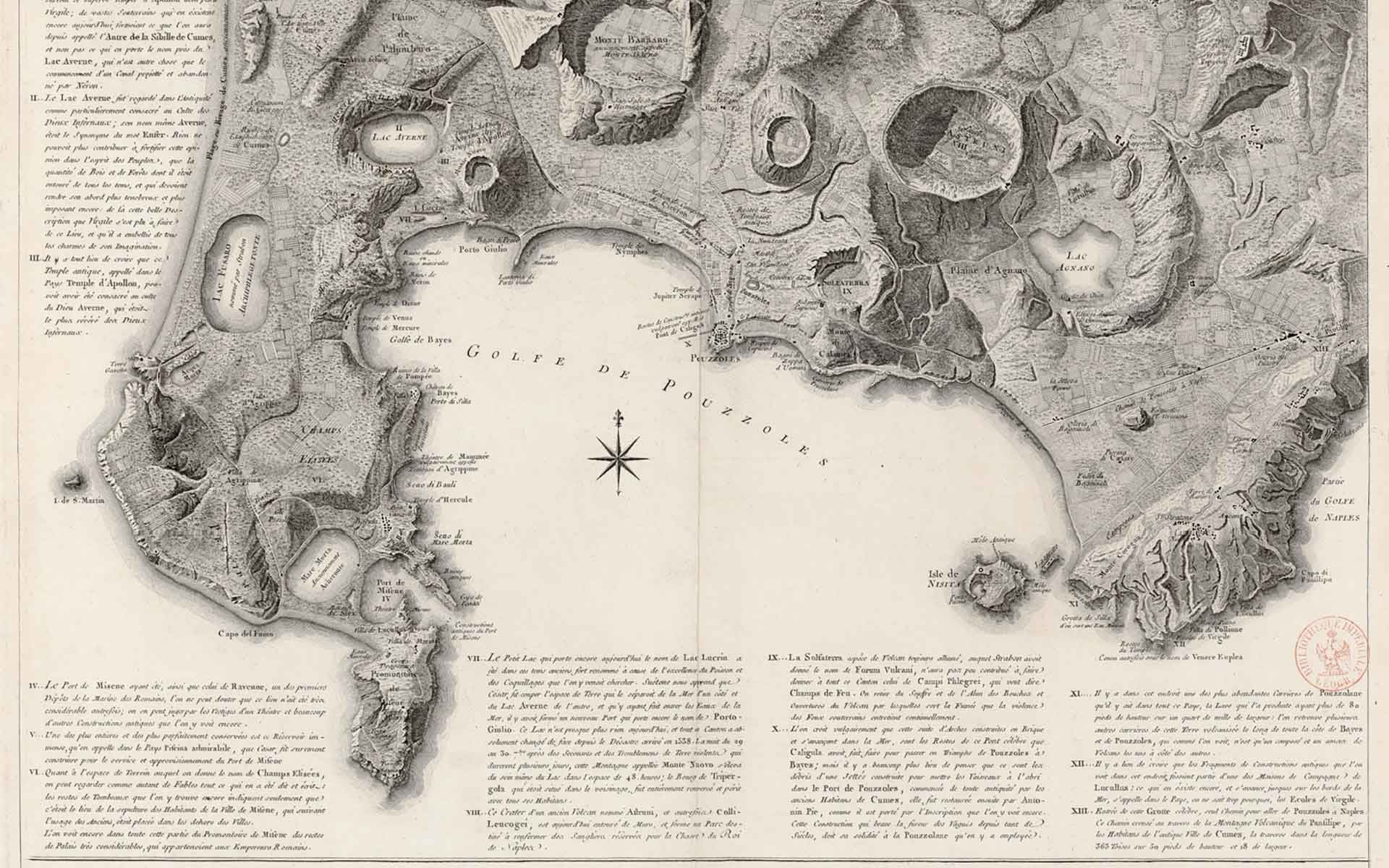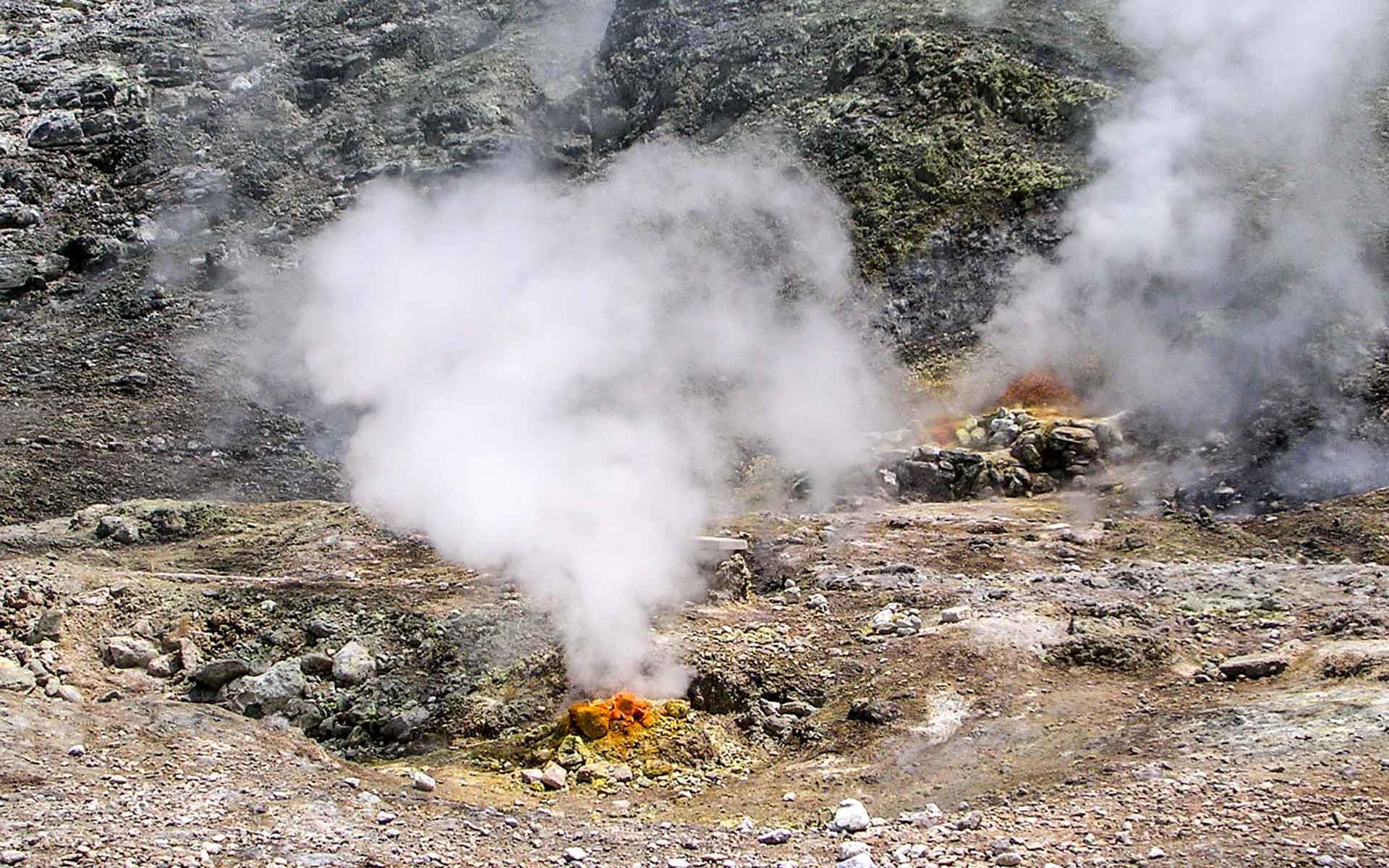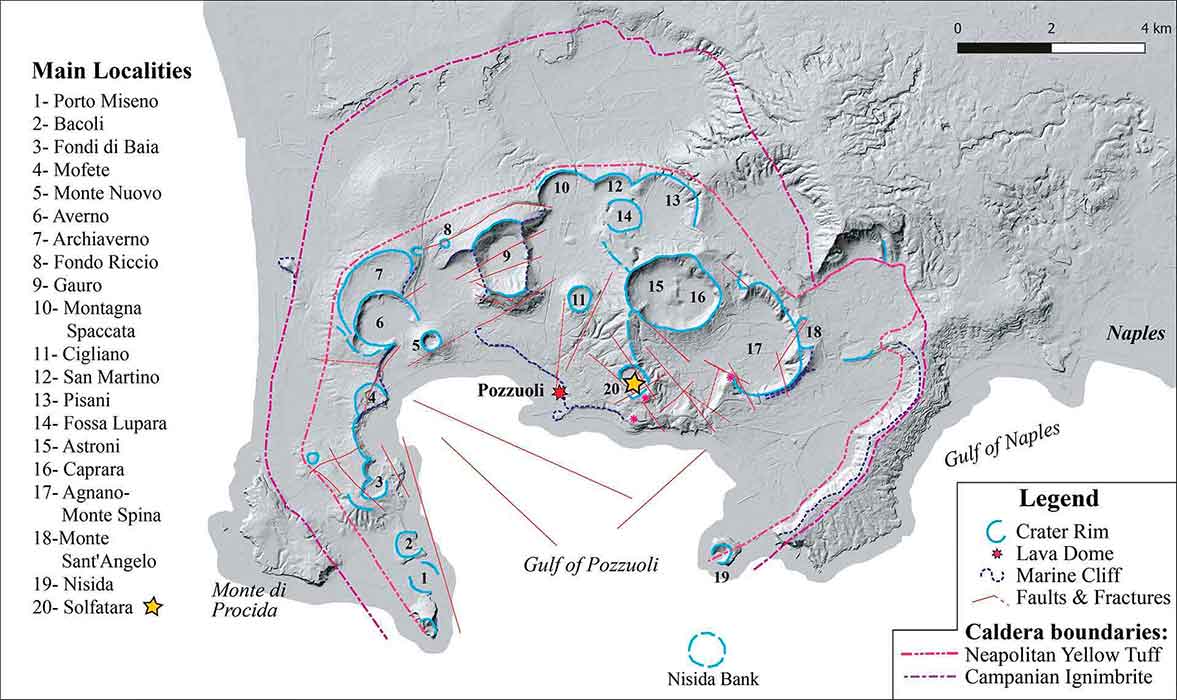
Map of the Gulf of Pozzuoli, with a part of the Phlegrean Fields, drawn by Pietro and Francesco La Vega in 1778, printed by Perrier in 1780 (Carte du Golfe de Pouzzoles: avec une partie des champs phlégréens).
Geological Period
Upper Pleistocene – Holocene
Main geological interest
History of Geosciences
Volcanology
Location
Campania, Naples. Italy.
40°49’37.0″N, 14°08’20.0″E
Map of the Gulf of Pozzuoli, with a part of the Phlegrean Fields, drawn by Pietro and Francesco La Vega in 1778, printed by Perrier in 1780 (Carte du Golfe de Pouzzoles: avec une partie des champs phlégréens).
A classic area for the study of volcanic activities and volcanic hazard assessment since the 18th century.
The site had a major role in the European debates that created the modern science of geology in the 18th and 19th centuries. Naturalists were attracted to the area to record evidence directly in the field regarding both active and extinct volcanoes and their products preserved in the landscape. The Phlegraean Fields is one of the very few volcanoes in the world considered capable of producing a colossal eruption of level VEI 8 (Orsi et al., 2004), which had already occurred during its volcanological history with the emplacement of the Campanian Ignimbrite that supposedly caused the near disappearance of Neanderthals (39ka).
- Geological description
The Phlegrean Fields volcanic complex is a 13 km wide nested volcanic caldera complex located west of Naples, near Vesuvius, famous for the iconic Temple of Serapis, with evidence of vertical ground movements since the Roman period. The volcanic complex started its activity c.80 ka BP. That activity ranged from phreatomagmatic-magmatic explosions to effusive eruptions. The present volcanic structure results from major collapses related to the Campanian Ignimbrite (39 ka) and the Neapolitan Yellow Tuff (15 ka) emplacement. During the last 12 ka volcanism has been concentrated within the former area forming tuff cones and rings, minor scoria cones, and lava domes. Intense ground deformation generated by uplift and subsidence phenomena indicates the presence of an active volcanic system associated with hydrothermal fluid inflation-deflation processes. In the famous locations of Solfatara and Pozzuoli this activity is particularly evident. The Solfatara crater is characterized by high temperature hydrothermal fluid discharge, boiling pools, and diffuse CO2 emissions. In recent decades Pozzuoli has undergone several episodes of bradyseism, raising the coastline by c.4.5m. Today, the area is highly monitored as a rapid release of magmatic gases or new magma intrusion could trigger a significant eruption at anytime (Sbrana et al., 2021; Orsi et al., 2022).
- Scientific research and tradition
The site is one of the most intensively studied volcanic area in the world, ranging from the observations by Ray (17th century), to Spallanzani and Lyell in the 18th and 19th centuries (Dean, 1998). A focal point in this research, based on fieldwork, was the work of William Hamilton (1776-79).
- Reference
Dean, D. (1998) ‘Italian volcanoes and English observers’, in Volcanoes and History: Proceedings of the 20th INHIGEO Symposium, Napoli-Eolie-Catania (Italy) , 19-25 September 1995. Genova: Brigati, pp. 99–122.
Di Vito, M.A. et al. (1999) ‘Volcanism and deformation since 12,000 years at the Campi Flegrei caldera (Italy)’, Journal of Volcanology and Geothermal Research, 91(2), pp. 221–246. Available at: https://doi.org/10.1016/S0377-0273(99)00037-2.
Hamilton, W. (1776) Campi Phlegraei. Observations on the Volcanos of the two Sicilies as they have been communicated to the Royal Society of London. Naples: Fabris.
Isaia, R. et al. (2019) ‘High-resolution geological investigations to reconstruct the long-term ground movements in the last 15 kyr at Campi Flegrei caldera (southern Italy)’, Journal of Volcanology and Geothermal Research, 385, pp. 143–158. Available at: https://doi.org/10.1016/j.jvolgeores.2019.07.012.
Orsi, G., D’Antonio, M. and Civetta, L. (eds) (2022) Campi Flegrei: A Restless Caldera in a Densely Populated Area. Berlin Heidelberg: Springer Book Series (Active Volcanoes of the World).
Orsi, G., Di Vito, M.A. and Isaia, R. (2004) ‘Volcanic hazard assessment at the restless Campi Flegrei caldera’, Bulletin of Volcanology, 66(6), pp. 514–530. Available at: https://doi.org/10.1007/s00445-003-0336-4.
Sbrana, A., Marianelli, P. and Pasquini, G. (2021) ‘The phlegrean fields volcanological evolution’, Journal of Maps, 17, pp. 545–558. Available at: https://doi.org/10.1080/17445647.2021.1982033.
- Author(s)
Alessandra Pensa
Istituto Superiore per la Protezione e la Ricerca Ambientale (ISPRA), Roma, Italy
Roberto Bonomo
Istituto Superiore per la Protezione e la Ricerca Ambientale (ISPRA), Roma, Italy
Martin J.S. Rudwick
International Commission on the History of Geological Sciences (INHIGEO)
Kathleen Histon
International Commission on the History of Geological Sciences (INHIGEO)


